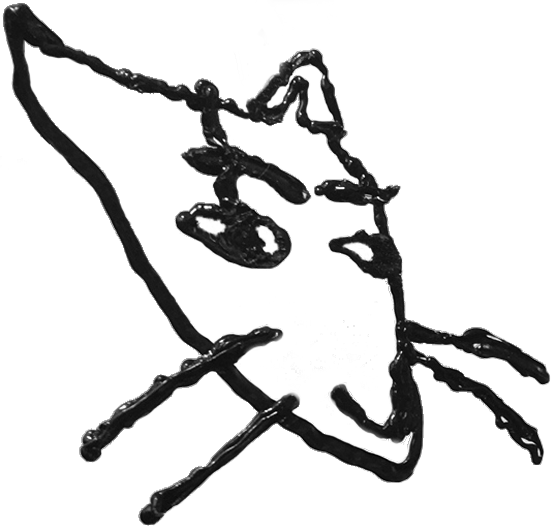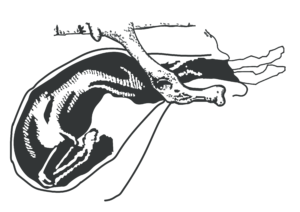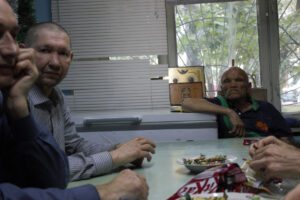If I described the Neue Galerie and its Sabarsky and Flederhaus Cafés as a theme park, it would, of course, be taken as an insult. The epithet “theme park” implies tawdriness, vulgarity, heavy-handed facades, and a thoroughly ignoble concern with fulfilling a patron’s fantasies merely to pump their wallet and churn them through for the next.
The Neue itself—a delicate, rigorously curated collection of German and Austrian art in a sedate stone mansion two blocks up 5th Avenue from the Met—is a paean to aesthetic sophistication and sincerity. But it is also a theme park. The mansion is not merely a gallery, a neutral space to showcase the objects in its collection. Along with its restaurants and gift shop, the Neue is an immersive experience calculated to evoke the world of the turn-of-the-century Central European intelligentsia, with its strange, captivating combination of revolutionary sentiment, iconoclasm, and fascination with the demise of the old-world traditions out of which it was born.
With its tall, bare windows, white marble tables perched on sinuous pedestals, chandeliers, and sacher torte, the museum’s Café Sabarsky is a recreation of the Viennese cafes that attracted the artists and thinkers of turn-of-the-century Austria, to whose work the Galerie is home. The detail is meticulous—from the 1912 Otto Wagner upholstery on Adolf Loos furniture and the bratwurst and Bohemian red wines on the menu to the weekly “Cabaret at Café Sabarsky” series showcasing German and Austrian music from the 1890s to the 1930s. A Bosendorfer piano looms conspicuously in the corner, and, in the daytime, the air is filled with Dvořák and Lizst.
The evocation is seamless, dense, elegant, and convincing. When I visited the Café one slow afternoon, two birdlike older women in flawlessly tailored wool tweeds sat sharing a kirsch-laced strudel at a corner table. “I adore this place,” one informed me, entirely unprompted. “It’s like the cafes I’ve been to in Dresden.”
A moment’s thought, and I realized, yes. I could think of at least two places I’d visited in Dresden that were almost identical to the Sabarsky, and more like them in Prague. And they were all exactly the same. The same sort of space, the same array of sausages, the same music, the same conjuration of Weimar decadence sans Weimar bawdiness, and above all, the same intimation that to partake of an espresso or a glass of Grüner at one of the tiny tables was to participate in a grand cultural tradition. These restaurants—and the Neue Galerie itself—were all elaborating a myth, and doing a damn good job of it. I wondered if Egon Schiele or Paul Klee had ever graced a place similar to the Sabarsky, or if they, magically brought through time, would find the caricature apt.
I began to be faintly offended. We were all sitting here, consumers of an elaborate ruse resurrecting a past that never existed as such, and which consisted of cramming six or seven decades of dispersed artistic and intellectual genius into a space that seated about thirty and selling tickets to the experience. Looking around the Café at my fellow patrons, I felt I could soundly speculate that absolutely none of them would be caught dead enjoying themselves at Disney World. Theirs were the patrician pleasures, not the plebeian pastiche. And yet, here they were in what was most emphatically a theme park restaurant.
To meaningfully judge the Café Sabarsky against Chef Mickey’s on their merits as experiences, we cannot base our comparison on some nebulous, evasive ideal of authenticity.
But it is difficult to be offended while at the Sabarsky. As a waiter darted between the tables lighting candles to steady the evening’s falling light, I watched him through the fishbowl eye of my wineglass and realized that this was not what mattered. Deliberate reinterpretation and reproduction of past worlds isn’t necessarily disingenuous, and aesthetic fabrications and engineered facsimiles of semi-imagined places are found at every point on the spectrum between what is popularly regarded as “in good taste” and what is not. Our metropoles are full of them—from “fusion cuisine” restaurants to galleries installed in old factories to bars where every patron is addressed as “Mr. Bond,” everywhere we are presented with cocktails of intentionally recombined aesthetic strains and warped evocations of different cultures and histories.
So to meaningfully judge the Café Sabarsky against Chef Mickey’s on their merits as experiences, we cannot base our comparison on some nebulous, evasive ideal of authenticity. Neither would measure up, and the ideal itself would be shown up as a tactic to avoid the admission of bald class signaling. Rather, we must ask what draws people to the different imaginary worlds that different experiences allow them to enter.
Who is beguiled by a low-lit, luxe, pre-war Viennese fantasy zone, and who flocks to sunny Main Street U.S.A. with its Disneyfied dentist-office façades?
Class difference immediately suggests itself as an explanation for the whom and why of these two fantasies. A certain sort of cynic would point out that art museums and gourmet cafes are more expensive than theme parks and theme park restaurants, and conclude that difference in cost dictates a difference between the socioeconomic circumstances of the individuals who frequent them. But that is patently untrue—a low-cost day trip to Disney World today clocks in at a little over a hundred dollars with a typical meal costing half that¹, while the Neue charges only twenty-two dollars for admission and perhaps eleven for a slice of Linzertorte.
Of course the relative costs aren’t comparable, as such, because one is an all-day excursion or a vacation and one is not. No-one is going to spend a weekend at the Neue Galerie, and it’s already expensive to be in New York. But this undermines the pervasive notion that experiences touting high sophistication are accessible only to the monied few. If money is a factor in what theme park one visits, then, for many people at least, it intersects with aesthetic predisposition at some place other than the ticketing office.
So what does make the difference?
When I step into a theme park environment, I must reinterpret myself. How at home can I feel in the unnatural fantasia I’ve just entered? Can I emphasize, to myself, traits of my appearance, bearing, and preference such that I feel some version of me belongs there? Can I play along? We are drawn to the imaginary places in which we feel we, or a version of ourselves that we like, may feasibly fit.
The two tweed-clad Upper East Side women perched picking at a strudel at the Sabarsky clearly felt that they fit. They were practically flush with a serene satisfaction at how well they fit—to the point where one made a point of letting me, a complete stranger, know that she had fit just as well in another place just like this one. I’ve seen people do this in many places —demonstrate, to themselves and to anyone watching, how at home they are. And I’ve seen them do the opposite. Were one of these prim, cosmopolitan dâmes somehow cajoled into a trip to Frontierland, she would without a doubt spend over half her stay lamenting the tackiness of the same over-scaled faux-foliage decor that sends other people into transports of delight, because she felt out of place. Frontierland is not her imaginary world the way the nineteenth-century Landständischer Saal might be. Why is this?
Decadence looks around, sees nothing but rotten fruit, and gathers it in sticky armfuls to distill into liqueur.
Frontierland does not evoke decadence. It is an escape from any acknowledgement of decadence, in spite of the fact that every aspect of the place—every queso-smothered waffle fry, every decorative horseshoe, every ride and view and promenade—is purely and unabashedly for leisure. It is good wholesome fun, above all. The imagined past it evokes is bracing, gamblesome, brusque, full of outdoor adventure and seeking-one’s-fortune.
The same can be said for Adventureland, with its pirate impersonators and treehouse nooks. There’s a Fantasyland as well, wrought out of an idealized medieval Europe populated by dragon-slaying gallants. And Tomorrowland, though it conjures up a utopian future rather than an idealized past, evokes the same sort of hopeful enthusiasm for what awaits the intrepid. Frontier, Adventure, Fantasy, Tomorrow—these are worlds where striking out towards the unknown is rewarded. To imagine oneself there encourages a devil-may-care but self-possessed attitude, not a scrutiny that would sound the experience for plausibility or authenticity.
Who fits here? Who wants to fit here, tailors and cultivates their self-concept such that they do, and comes here to live it out ?
It’s tempting to answer with some form of “Children, of course, with their put-upon parents in tow.” But while theme parks tend to cultivate a childlike, cartoonish innocence of aesthetic and present themselves as family-centric experiences, children are not predominantly the ones drawn to the fantasy worlds they create. Nearly half the theme park visitors in America in the last five years have been between eighteen and twenty-nine², and about sixty percent of Disney World’s visitors come from households where there are no children under eighteen³. Children, on the whole, have yet to acquire the complex learned tropes (about pirates, about castles and castaways) that theme parks are slavishly engineered to match. Children need much less—the real-life world in front of them is still alive and they are unstoppably adventuring into it. Their dragons require less set-dressing. It’s adults whose hopes and expectations these places cater to, even if said hopes and expectations are of a return to childlike gameness and enthusiasm.
Should these adults be chided for puerility? Or should they be empathized with? After all, I would not like to say that idealizing opportunity is inherently unhealthy, especially in a world bereft of it and where some form of desperate stagnation is the common circumstance. A theme park like Disney World lets visitors imagine themselves in a world without stagnation, without decadence, and within which playing along is rewarded. No-one who visits Disney World pretends that its imagined worlds are faithful reproductions of anything else at all, but they flock to them and ride the rides and yell and eat and drink because they feel at home in the narratives made manifest around them. Why would they scrutinize the aesthetic means via which they do so? Much better to allow sheer participation mystique to carry you happily along.
Decadence, by contrast, requires a sort of scrutiny. It needs a sense of its own deserved doom, its own complicity in its lack of influence on its future. Decadence looks around, sees nothing but rotten fruit, and gathers it in sticky armfuls to distill into liqueur. It does this in an informedly fatalist manner, taking pride in its self-awareness but without the hope that such insight will provide any way forward. Decadence absolves its participants of their potential for honest adventure, in a sense: it’s all been eviscerated anyways and God is dead. We know—why not wallow? There are no frontiers left but the self and fashion, so why not glorify self-obsessed, self-immolating artistry and romanticize emotion? Why not dabble in psychoanalysis?
The fin-de-siecle European intelligentsia could easily be called an object lesson in decadence. Decadence arises in the lame-duck stages of its setting, and the geopolitical moment at the turn of the twentieth century was one studded with geriatric empires and outmoded political systems unable to navigate a world shrunk by new technology and burgeoning with nouveau-bourgeois energy.
When Europe’s atavistic imperialism at last exhausted the available frontiers, the effects were not merely geopolitical. They reverberated in the sociocultural spirit, amplified by a new middle class with the discretionary income to spend on art and leisure. Once there was nothing new under the sun to courageously conquer and then goggle at, European culture became fixated on the dissection and veneration of what already existed but which it had taken for granted: the self, the nation, the family. Hence, existentialism, Expressionism, psychoanalysis, phrenology, Victorian morality. Hence jingoistic nationalism and literature self-consciously participating in what were, for the first time, conceived of as self-referential national literary traditions. If there is nothing new, there is little to do but dissect and scrutinize.
In America, Frederick Jackson Turner formulated his “frontier thesis,” which, while wildly reductive in its initial application to American national character, observed credibly that some sort of “vital forces” within a society were engaged in an outwards thrust at its frontiers. At the waning of the nineteenth century in Europe these forces turned inward, onto themselves and against each other. And this redirection led to a decadent profusion of intellectual and artistic work as surely as it led to the First World War.
The prewar Austrian world that the Neue Galerie and Sabarsky Café evoke with such studied precision is one of decadent scrutiny. That Expressionism, the art movement that dominates the Neue’s collections, arose under the described conditions should seem unsurprising. It can be understood not only as an avant-garde art style, but as an attempt at a new understanding of the individual in the wake of Marxist, Darwinian, and Freudian challenges to the idea of the human person as an autonomous being in possession of a rational mind and an eternal, transcendent soul. It attempted to portray subjective experience and transient emotional states, resulting in unrealistic, fantastical, distorted depictions of individuals, situations, and dreamscapes.
To stand in a room full of expressionist Groszs and Kubins and Kokoschkas is to be bombarded with the sense that what is most real is not identity, history, or the opportunity to build on what’s there, but heady, dislocated instants of emotion and circumstance to which one is now a voyeur. This imaginary world of Mitteleuropa artists and intellectuals estranged from tradition and unable to imagine a future is what the Neue Galerie and its restaurants deliver in super-condensed caricature to their visitors. It is a world stuck at a precipice of identity renegotiation that has dissolved its grip on identity itself. It can neither advance straight forward nor go back, and so descends, paralyzed, into decadent navel-gazing. To enter this world presumes—requires, even—a similarly infertile scrutiny from those who enter it.
No-one is intrepid in the face of decadence except Savonarola. And decadents know better than to burn books because artistic and scientific additions to the human record are the one defensible thing that the concentrated wealth that accompanies decadence has brought to humankind. But it is difficult to be offended, in the midst of decadence, by anything except the intimation that one could be or think any other way.
Who aspires to this? Who belongs here?
I do, I realize.
I bear many of the hallmarks of a vaguely masochistic argumentum ad decadence with regards to myself. I live at the end of history, or one of them at least, and I know it, and my friends and acquaintances discuss our asymptotic approach to it constantly. I live in a world where the systems-that-be are vast and lumbering and gerrymandered and voracious, by experience unstoppable but by necessity doomed, and I know it. Speculations about what may follow in their wake are innumerable and presumptive, and to watch them prey on each others’ vapor-spun castles inspires no sense of the future at all. All avenues for self-understanding manifestly available to me rely on aesthetic consumption and expression in the guise of productive exploration. And so, I am drawn inevitably to romanticizations of past eras with a similar tragic fraughtness, lack of promise, and frenetic self-absorption in the face of stagnation. The fin-de-siecle Central Europe reproduced within the Neue delivers this in spades.
But just because I feel at home at the Sabarsky doesn’t mean I like it. I can recognize the same stance in other people I know, and see the unwholesome, hypocritical pointlessness of a life lived there. But I also can’t help but feel the gulf of unrealism between me and any fantasy world that trades on action and opportunity, and between me and anyone who easily embraces such a fantasy. Has compulsive scrutiny and disbelief in my own agency become so much a part of me that I cannot even seriously fantasize about a less circumscribed reality?
Perhaps it has. But to conclude that I am correct in assuming this stance would require me to claim knowledge of the whole space of the possible in the same breath. Which, thank god, I cannot and will not do.
1. https://www.wdwinfo.com/walt-disney-world/how-much-does-it-cost-to-go-to-walt-disney-world-for-one-day/
2. https://orlando-rising.com/theme-park-demographics-changing-higher-incomes-and-more-millennials/
3. https://www.streetlightdata.com/measuring-travel-behavior-disney-world/




